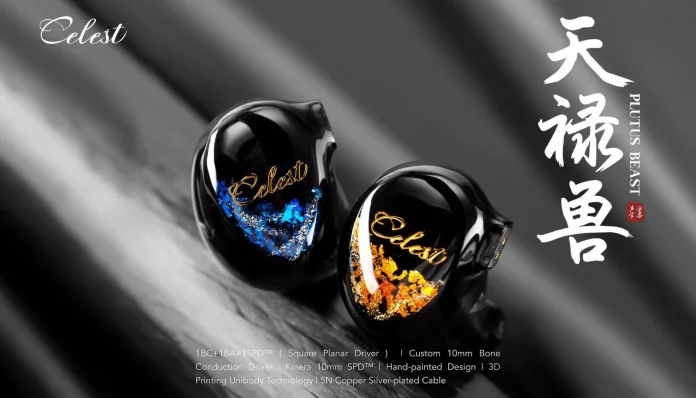In this article, I’ll be examining the Kinera Celest Plutus Beast IEM. Plutus Beast is a three-way IEM with bone conduction, a square planar driver, and a balanced armature driver. It is priced at $89.
Disclaimer: Kinera provided this sample for an honest Review. All of the observations and comments presented here are my own, based on my experience with the product.
Kinera Celest Plutus Beast
Specifications
- Current Price: $89 Byu it from (Kinera, Amazon, Aliexpress)
- Key Features
- Three-Driver Tribrid Configuration
- 1BC+1BA+1SPD(Patented Planar Driver) Acoustic Structure
- Custom-developed 10mm Bone Conduction Driver
- Second-Gen Self-Developed Square Planar Driver
- Balanced Three-Frequency Tuning
- Exclusive Design With Hand-Painted Face Covers
- 3D Printed Integrated Molded Ear Shells
- High-Purity 5N Copper Silver-Plated Cable
- Rich Accessories
- Drivers: 1 Bone Conduction Driver + 1BA + 1 SPD™ (Square Planar Driver)
- Impedance: 8 ohm
- Sensitivity: 108 dB
- Frequency Response: 20Hz-20kHz
- Cable: 5N Copper Silver Plated
- Plug: 3.5mm / 4.4mm Balanced
- Eartips: Celest 221 Vocal Eartips, Celest 608 Balanced Eartips

What In the Box
- Kinera Celest Plutus Beast IEMs
- Detachable 0.78mm 2-pin silver-plated cable
- Zipper carrying case
- 6x pairs of silicone eartips
- Metal bookmark
- Cleaning tool

Design
The Plutus Beast’s 3D-printed shells are undeniably intriguing, especially the meticulously hand-painted faceplates. There are three colourways: blue, golden, and blue-gold. The shells have a glossy black body and excellent overall build quality.
Plutus Beast’s stock SPC cable is consistently braided and features a smooth, clear sheath. It’s a visually appealing cable with aluminum components. It handles well and does not have any microphonic issues. It’s an excellent cable that is of higher quality than we’re used to seeing supplied with a $89 IEM.

I’ll begin this part by addressing a serious issue with the Kinera Celest Plutus Beast that no one seems to be talking about: the bone conduction driver (BCD). When an object vibrates, it causes pressure waves in the surrounding medium, whether it is air, water, or solids. The BCD is meant to improve the low-frequency response, and it succeeds—bass notes have more body and character.
The problem stems from its sensitivity. Any minor impact activates the BCD inside the shells, causing an irritating ringing resonance in your ears. Furthermore, the resonance of my own voice while speaking can trigger the BCD. Male voices, in particular, tend to set them off, which is distracting and bothersome; try chewing gum or listening to a podcast with two males conversing and you’ll see what I mean. In my perspective, that is a severe issue, and the technology, or at least its execution, requires better.

Sound
Testing equipment included the Earmen Angel, Simgot DEW4X, and HiBy R3 II. Plutus Beast is an effective IEM that does not require a powerful source.

Bass
For me, the bass is the highlight of Plutus Beast’s sound, and it demonstrates the true benefits of the BC driver. Bass notes are beautifully textured, muscular, and gritty. The bass is powerful and commanding, but it is still controlled in terms of volume.
Furthermore, the Plutus Beast’s bass reproduction extends impressively into the sub-bass zone, giving a tactile experience with profound resonance. It accurately reproduces low-frequency subtleties and rumbling, providing depth and texture to the music.
Midrange
Plutus Beast’s midrange is diverse, with a mix of strengths and drawbacks. The upper midrange is a challenge because it leans toward a “shouty” character. There is also a propensity for vocals, particularly male ones, to resonate in a way that activates the BC driver, resulting in an artificial tone.
It’s a midrange with a mix of warmth and forwardness. At its best, this combination adds richness and depth, improving overall musicality. However, during busier portions, the midrange can falter, resulting in congestion that reduces clarity and separation.
Treble
Plutus Beast’s treble performance has some distinguishing features that affect its overall sound profile. Most noticeably, the upper treble extension falls short, resulting in a lack of airiness and sparkle. This reduces detail recovery, resulting in a darker overall tone that may not appeal to people looking for a more vivid and lively sound. On a good note, the treble is smooth and unfatiguing.
Soundstage & Technicalities
In terms of technical performance, the Plutus Beast is somewhat lacking. While the soundstage dimensions are typical, it has a significant forward depth. Positional placement is average and imprecise. Furthermore, the instrument separation and layering are very standard for a product in this price bracket.

Overall Impressions and Final Thoughts
In conclusion, the Kinera Celest Plutus Beast is a bit of a mixed bag. On the one side, it has a beautiful design and build quality, and it has a solid stock cable and accessories. Plutus Beast’s powerful, thrilling bass response distinguishes it from its counterparts.
However, despite its virtues, there are several drawbacks that limit its appeal. Timbre and tonal balance issues cloud its performance, reducing coherence and fidelity. The unwanted ringing of the bone conduction driver, caused by vocal and instrument resonance, is especially bothersome. It’s still a nice IEM for the price, but I wouldn’t suggest it outright.


